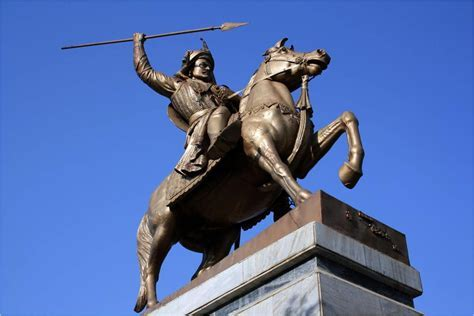In the annals of Indian history, Peshwa Bajirao stands out as a visionary leader who left an indelible mark on the Maratha Empire. Born on August 18, 1700, in Sinhagad, Maharashtra, he was the scion of Peshwa Balaji Vishwanath and Radhabai. From a tender age, Bajirao was groomed in the arts of warfare, diplomacy, and governance, showcasing exceptional bravery and intellect that captivated his father and other prominent Maratha leaders.
Peshwa Bajirao’s feats

At just 20 years old, Bajirao ascended to the position of Peshwa (Prime Minister) following his father’s demise in 1720. Eventually, he proved to be a skilled military strategist, expanding the Maratha Empire’s frontiers through a series of victories including the Battle of Delhi (1737), the conquest of Malwa (1738), and the Battle of Bhopal (1738). His military campaigns also led to the expansion of Maratha territories in the south.
Bajirao’s administrative acumen was equally impressive. During his reign, he established a robust army and a network of spies and intelligence agents and promoted trade, commerce, art, literature, and culture. His reforms had a lasting impact on the Maratha Empire, transforming it into a dominant power in India.
Peshwa Bajirao’s legacy is a testament to his remarkable leadership, bravery, and intellect. Evidently, he inspired future generations with his vision, courage, and administrative prowess, leaving an indelible mark on Indian history. Although this happened about 300 years ago, his contributions continue to be celebrated and studied today, cementing his place as a true hero of Maratha history.

All the battles the Peshwa Bajirao fought and won :
Battle of Delhi (1737)
In 1737, Peshwa Bajirao led the Maratha Empire to victory against the Mughal Empire in Delhi. The Mughal Empire’s weakness and internal conflicts created an opportunity for the Marathas to expand their territories, consequently, Bajirao’ s forces breached the city walls and captured Delhi, forcing the Mughal emperor to flee. This victory marked a significant expansion of Maratha’s territory and power.
Conquest of Malwa (1738)
In 1738, Bajirao led the Maratha Empire to conquer the Malwa region, which was then under Mughal control. The Marathas defeated the Mughal governor and his forces, capturing key cities and forts. This conquest marked a significant expansion of Maratha territory and resources
Battle of Bhopal (1738)
In 1738, the Mughal governor of Bhopal resisted Maratha expansion, leading to a battle between the two forces. Bajirao’ s army emerged victorious, capturing the city of Bhopal and expanding Maratha territory.
Campaigns in the South (1739-1740) Peshwa Bajirao
In 1739-1740, Bajirao led the Maratha Empire to expand into southern India, defeating the Nizam of Hyderabad and the Sultan of Mysore. These victories marked a significant expansion of Maratha territory and influence in the region.
Peshwa Bajirao’s remarkable legacy continues to inspire awe and admiration. As a visionary leader, he catapulted the Maratha Empire to unprecedented heights, harnessing his military genius, strategic acumen, and leadership prowess to expand its frontiers. Beyond his impressive conquests, Bajirao implemented groundbreaking administrative reforms, fostered trade and commerce, and patronized art and culture with unwavering enthusiasm. His indomitable spirit, unwavering dedication, and unrelenting passion for his empire have etched his name in the annals of Indian history as a colossus, a true giant among leaders.
Some intriguing aspects of Peshwa Bajirao’ s persona include:
– His
lightning-fast military maneuvers earned him the sobriquet “Rao,” connoting speed and agility.
– Bajirao’s
diplomatic finesse and strategic brilliance enabled him to navigate complex political landscapes with ease.
– He
was a discerning patron of the arts, supporting luminaries in music, literature, and visual arts.
– Under his
aegis, the Maratha Empire’ s territorial expanse stretched from the Indus River to the Tamil Nadu coast.
– His
life and times have captivated the imagination of scholars,
artists,
and the general public,
inspiring a plethora of literary,
cinematic,
and televisual works.


